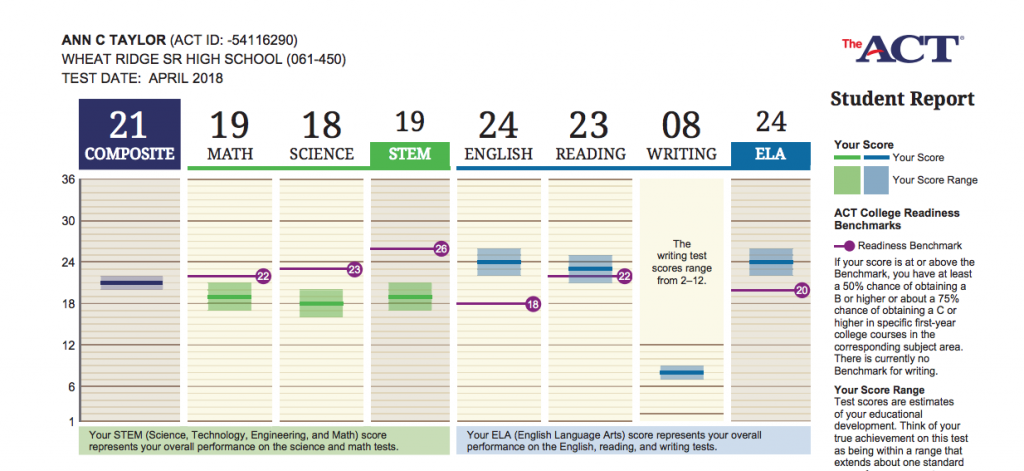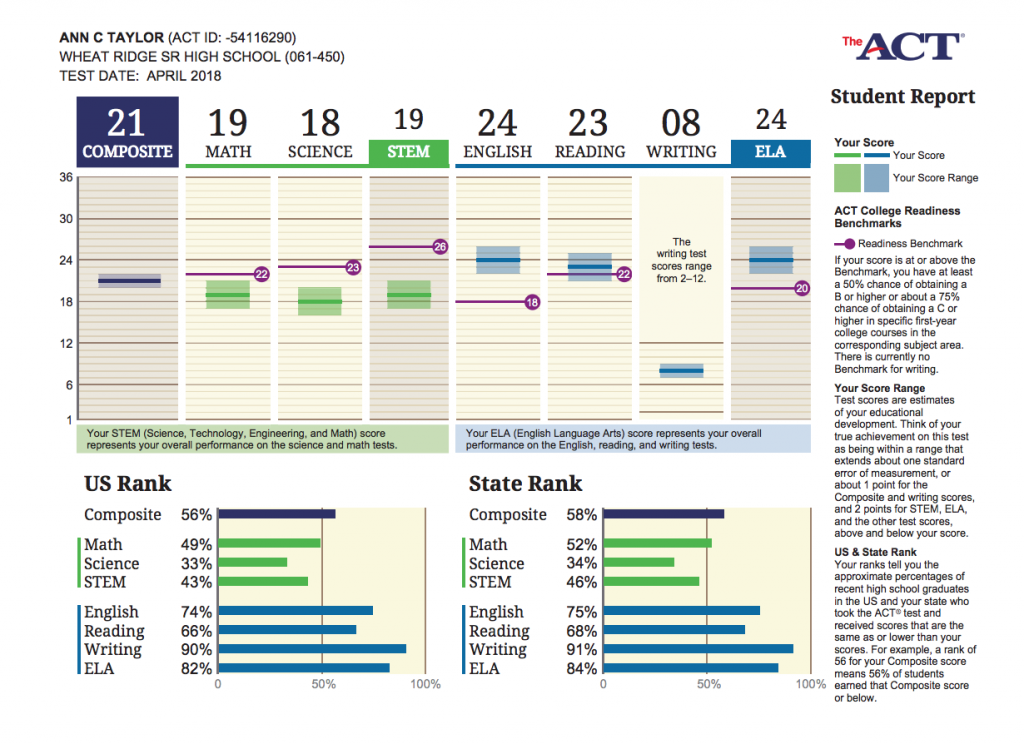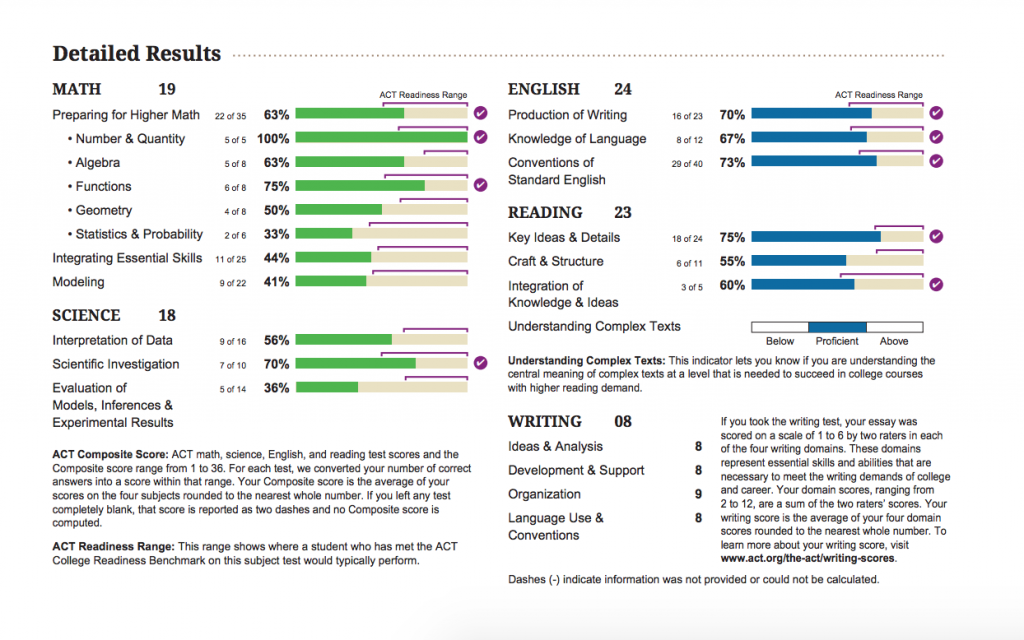Congrats – you took the ACT test! Now that your ACT score has come out and your report has arrived in your online portal, it’s time to take a look at your score. Did you perform as expected? Do you need to improve your ACT score? How should you interpret the different scores you see on your report?
Using a sample ACT score report, we’ll walk you through the four steps to interpret your ACT score report:
- Evaluate your composite and scaled scores
- See how you compare to averages
- Evaluate your detailed results
- Make a study plan!
1. Evaluate Your Composite and Scaled Scores
The score in the top left, highlighted in purple, is your composite score. It is the average of your scaled scores. When you look up ACT averages for your school, this is the number they are referring to. We wrote an in-depth post about how the ACT is scored if you’d like more information on how your score came to be.
STEM and ELA Scores
The scores directly to the right are your scaled scores for each section of the test. Your STEM score is an average of your math and science scores. Your ELA score is an average of your English and Reading scores. These scaled scores help you see how you did on each section of the test.
Readiness Benchmark
You’ll notice a purple “Readiness Benchmark” line with an associated score for each section of the test. According to the ACT’s research, if you meet or exceed this benchmark, you have about a 50% chance of earning a “B” or higher in your freshman level classes related to the subject area.
While it’s great to meet or exceed these benchmarks, keep your personal goals in mind. What is the average ACT score range for the schools you are applying to? What types of schools are you applying to? Are you applying to a STEM school or major? If so, you should definitely meet or exceed the STEM benchmarks. However, if you’re applying to a liberal arts school or major, it’s probably not as important to have top STEM scores.

2. See How You Compare to Averages
The average ACT score in 2020 is 20.7. If you exceed this score, you’ve already done better than the average ACT test taker! You can see how your score compares to others who took the test nationally and in your state with the “US Rank” and “State Rank” charts below your score report.

3. Evaluate Your Detailed Results
Finally, take a look at your detailed results. This may be the most helpful section of your score report for determining your study plan going forward because the report shows how many of each type of question you got correct. As you evaluate, remember to study what counts.

First, look at the subcategories that are the lowest; these are the areas you need to practice before taking the test again. Then look at your higher subject test scores and determine which subcategory is causing you greater difficulty. Since this subject test score is higher than others, you must be strong in this subject; thus, you may find it easier to improve.
Generally, the areas that show the most significant improvement after practice are areas that are lowest – nowhere to go but up – and areas where you are strongest because it is probably more about tweaking than learning something new.
Also, you want to think about which subcategories represent a greater proportion of questions within the subject. For example, there are only 5 “Number and Quantity” math questions, but 22 “Modeling” questions. If, in this example, you didn’t do too hot in both of these sections, then it is more strategic to study the Modeling questions as there will be more of them on the test.
But what exactly are Modeling questions? What are “Knowledge of Language” questions? The ACT has provided descriptions of their question categories on their website:
- Description of the Math Test
- Description of Science Test
- Description of English Test
- Description of Reading Test
Types of Questions in the Subcategories
Here is a snapshot of the kinds of questions that fall into each reporting category and the percent of questions on the test you can expect to find.
English Subcategories
The English section has 75 questions total. There are 3 reporting categories:
Production of Writing ~30% of questions
Think about those questions that require you to understand the intended purpose of the writing. This reporting category has 2 subcategories:
- Topic Development: questions about whether a part of the writing has achieved its intended purpose and the accurate use of rhetorical devices
- Organization, Unity and Cohesion questions about the logical structure of the writing
Knowledge of Language ~15%
Think of these questions like word choice. You always want to select the words/phrases that are clear, concise, and avoid redundancy.
Conventions of Standard English ~55%
These are what we think of as “grammar” questions. This reporting category has 3 subcategories:
- Sentence Structure and Formation – questions about clauses and combining sentences to create clear, correct sentences
- Punctuation – questions about commas, semicolons, colons, periods, apostrophes
- Usage – questions about verb tense, subject-verb agreement, pronoun usage, and pronoun agreement
Math Subcategories
The Math section has 60 questions. There are 3 reporting categories:
Integrating Essential Skills ~40%
These are all the skills that you learned before Algebra 1. These skills could be used to answer a multi-step word problem involving fractions, percents, or proportions. They are most often required to answer questions that also fall into other categories.
Modeling < 25 %
These are questions that require you to interpret data and the functions that model that data.
Preparing for Higher Math ~60%
This reporting category has 5 subcategories:
- Number & Quantity ~10% – questions about understanding real and complex numbers, the taxonomy of numbers, and radical simplification
- Algebra ~15% – questions about topics covered in Algebra 1 and Algebra 2: linear, quadratic, exponential, radical, polynomial, absolute value, and matrices. You must understand the forms of equations as well as applications, solve for unknowns, and understand the relationships that they model.
- Functions ~15% – questions about some of the types of equations as in the Algebra section but in function notation, including applications such as composite and piecewise functions
- Geometry ~15% – questions about general topics covered in Geometry (triangles, circles, quadrilaterals, similarity and congruence), trigonometry, and conic sections
- Statistics & Probability ~10% – questions about central tendencies (mean, median, mode), probability, and other questions that involve data.
Reading Subcategories
The Reading section has 40 questions. There are 3 reporting categories:
Key Ideas and Details ~55%
These questions are about the main theme, details from the passage, connections within the passage, and conclusions based on the passage
Craft and Structure ~30%
These questions are about the writing itself – word choice, author’s purpose, intended audience, points of view, and use of rhetorical devices
Integration of Knowledge and Ideas ~15%
These questions are about the author’s argument versus other arguments presented in the passage, delineating between author bias and objective reasoning
The Reading section will also provide a designation – below, proficient or above – of your ability to Understanding Complex Texts. If your designation is below, then you are struggling with denser passages. Additionally, this information is intended to tell you whether or not you are ready or prepared for the types of passages you will read in college.
Science Subcategories
The Science section has 40 questions. There are 3 reporting categories:
Interpretation of Data ~50%
These are questions that require you to understand and interpret tables, graphs, and diagrams
Scientific Investigation ~25%
These are the questions that require you to understand the steps, variables, and/or differences in experiment procedure and results
Evaluation of Models, Inferences, and Experimental Results ~30%
These are the questions that require you to draw conclusions and make predictions based on your understanding of what is given to you in the passage
The College and Career Planning Guide
You’ll notice a fourth section to your ACT score report: the college and career planning guide. This section of the report evaluates your fitness for your college major choice and career goals based on your ACT score. Really, it’s probably not telling you any new information.
Take a look, be realistic with yourself. If you know you consistently perform well in ELA but not STEM, a STEM major may not be your best fit. However, you know how hard you’re willing to work, and hard work gets you a long way in any field. Ultimately, don’t let the ACT tell you what major to choose.
4. Make a Plan
The last step in evaluating your ACT score is to make a plan for further action. Are you content with your score? Congratulations! Go ahead and send it to colleges.
Feel like you want to boost your ACT score a few points? It’s time to get to work. Create a study plan based on your test results that works with your schedule and stick to it. As you pull together your study materials, make sure you’re using quality materials that help you truly learn the content, not just memorize it. We’ve developed our online ACT course with this goal in mind: that you’d complete it with a firm grasp of the concepts you need to know to ace the ACT, not just cheap tricks or memorization that may or may not work on test day.
Happy studying!
More on ACT Scoring:
How is the ACT Scored?
What Do Colleges See on My ACT Score Report?

Pingback: How to Send ACT Scores to Colleges | The Olive Book Blog
Pingback: When Should I Take the ACT? | The Olive Book Blog
Pingback: When Should I Take the SAT? | The Olive Book Blog
Pingback: Tips for ACT Test Day: Last Minute ACT Strategies | The Olive Book Blog
Pingback: When Are ACT Scores Released? | The Olive Book Blog